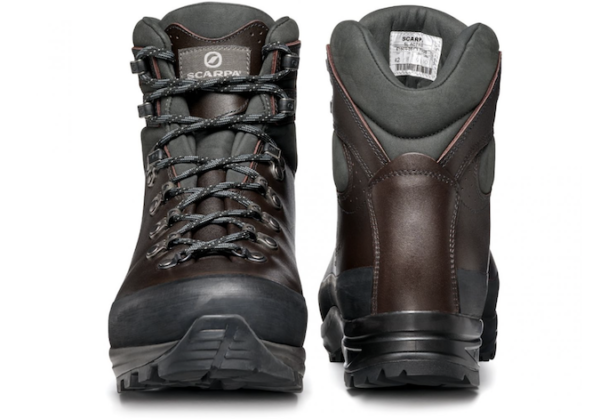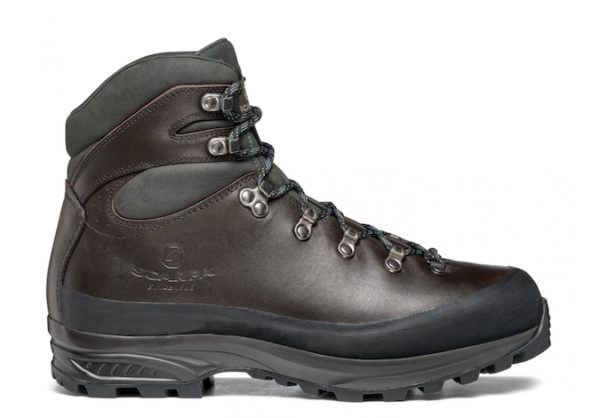I miss breaking in boots. It’s been years since I’ve needed to. Always felt like the start of a committed, loving relationship. I clean and wax the new leather, preserving it against water, then hike around in ’em everywhere for a few weeks. Sometimes unforgiving and tough at first, the boots eventually give way to the weird shape of my clown-like feet, and only get better and better as the years roll by on the ol’ odometer of life.
As I’ve covered probably to the point of being annoying, I kinda quit wearing trail runners on serious hikes a few years ago, but usually in favor of boots that are essentially just taller trail runners, with lots of foam, plastic, and synthetic fabrics. Light, fast, supportive, fairly inexpensive. And, embarrassingly, disposable. I hate that.
When I’m old, my daughters will see these boots in my house and remember backpacking trips we haven’t even taken yet.
So with a need for a burly hiking boot I can have for decades, as a replacement for some ooooooooold and re-soled Asolos I finally handed down to a friend in need of boots, I decided to nab a pair of Scarpa’s SL Active boots, their flagship full grain leather workhorse of a boot.
SL stands for “super leggero” which means “super light” in Italian. Now, I suppose that could be true, if these boots are compared with, say, cinderblocks. These are heavy boots. About 1 lb, 12 oz per boot. But that’s okay, it’s what I signed up for. Because when you heft these boots, it’s clear that’s 1 lb, 12 oz of quality. The workmanship looks to be excellent. The leather is beautiful. The eyelets are sturdy, straight and true. The rubber rand surrounding the boot is tough. The collar is nice and stiff but plush. The deeply lugged Vibram soles are clearly ready to bite into the toughest trails. So, you know—boots.
They don’t have a waterproof membrane. What they do have is full grain leather. It comes already treated with Scarpa’s brand of leather waterproofing cream. When that starts to break down, you apply more waterproofing cream, breathing more life into the leather. Out of the box they repel water like crazy. No issues there.
They do however have 37.5 Technology baked in. This is a relatively new fiber that uses volcanic and coconut material to create a kind of thermos effect of keeping cool things cool and warm things warm. It wicks moisture away very quickly, accelerating evaporation of water from your skin, shedding heat when hot, but traps infrared heat in, so you stay warm when you’re dry and cool.
This is the kind of thing that’s nearly impossible to convey or test objectively in a review. All I can say is I’ve not once thought about the temperature of my feet in the three seasons I’ve had the boots thus far. That’s impressive for a thick leather boot.
I’ve been wearing mine on most hikes for about 6 months now. I hike on average 20 miles per week, so that’s hundreds of miles so far in these boots. It took at least a third of that time before I truly felt like these were my boots, properly broken in to reflect my foot shape and stride pattern. These seem on the very slightly narrow side, but my feet seem to be relative to their size 12 length, of slightly less than standard width, Sio they fit me excellently and true to size. If you have particularly wide feet, you’ll know how to order accordingly.
For the first few dozen miles they actually felt okay, just very stiff. The weight of the boots is more apparent when they haven’t yet molded to your feet. It can feel a little like you’re carrying around weights on your feet. This is, I suspect, why so many people hate hiking boots. They don’t give them the time to truly break in.

Because once that happens, you realize you kinda only need two pairs of shoes. Hiking boots and sandals. Sure, trail runners are more immediately comfortable and if that’s your thing, that’s great, I like them too for some things. But short of running, I’d prefer every other foot-based trail activity with these puppies. I recently was hiking a section of the PCT near Sonora Pass, high in the Sierra. I encountered slippery wet snow on some dicey sections of the trail that were a borderline no fall zone. In other sections, deep, freezing mud. Then I spent a solid afternoon scrambling up and around sharp volcanic boulders and some nasty talus. The boots did everything I needed with complete confidence.
On another trip, I stuffed a pack with about 40 pounds of gear including an Alpacka raft for a high alpine fishing, floating day, strapped on the boots, and hoofed it over a classic Sierra granite and duff trail. It’s just so much safer, in my estimation, with boots like this than with softer, lighter weight footwear when humping a heavy pack.
And here’s the other thing, call me crazy, but part of those experiences is now worked into the leather of these boots. When I’m old, my daughters will see these boots in my house and remember backpacking trips we haven’t even taken yet. That sort of longevity may mean little to some, but I tire of disposable things. Shoes included. I like having a long-term relationship with my boots.
Oh I forgot to mention — you can resole these (according to Scarpa).
Now I still own other, non-leather boots that I like to wear for particular kinds of hikes, but that’s because I already had those boots. If I didn’t I could easily use these for everything I ever need to do outside.
•Frice (on sale now for $247)

